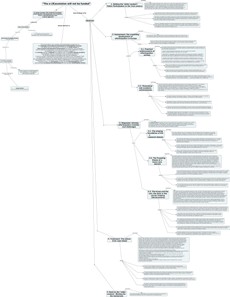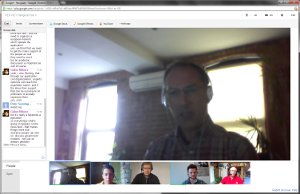
The invisible man
Today we held the second of two Google+ Hangouts with PEP-NET members. No real agenda, open to anyone who was interested, and not quite sure whether it would work. We gave it a go.
From an organiser’s point of view, the best things about doing a hangout rather than a text-based live chat (as we have done before with CoverItLive) is that i) the number of participants doesn’t need to be high for you to feel successful and ii) you can really see who is there and know that people were there for the duration. If I had organised a live text chat and six people in total had taken part, I would have been pretty disappointed.
Rather than writing boring minutes of the conversation, here is a collection of links to projects that were mentioned, as well as the websites or twitter accounts of the participants themselves. After all, it’s the taking part that counts, not the minutes.
Finland: Youth Initiative Channel, a project allowing youngsters to make suggestions/express wishes. Similar to FixMyStreet but about solutions, not problems.
(Some information in 2.3.1. of this report (PDF)), via @nadinekarbach.
Iceland: A group of citizens drafted a new constitution using online collaboration tools and presented it to the speaker of the parliament. Here’s a link that I found about the story, via @nadinekarbach (again)
Finland: The Finnish children’s parliament, via @nadinekarbach. (Now I feel like a kid copying someone else’s homework. Thanks Nadine.)
UK: 38 Degrees: a platform that brings people together to campaign, via @andywilliamson
The Danish Parliament puts videos of all its sessions online, and has made them fully searchable by users. Here’s an article I found about that. Thanks again, @andywilliamson
Participants:
Gábor Mihucz (Foundation for Societal Participation, Germany/Hungary), @GaborMihucz
Nadine Karbach (YouthPart, Germany), @nadinekarbach
Andy Williamson (FutureDigital, UK/worldwide), @Andy_Williamson
Hans Hagedorn (DEMOS eParticipation, Germany), @haans_en
Rolf Lührs (TuTech/DEMOS eParticipation, Germany), @somed
Peter Sonntagbauer (FUPOL), fupol.eu
… and of course me, @johnheaven
And PEP-NET is @pepnet.
So we’ve been feeling a little bit innovative for the past week too. After all, we worked closely with Schleswig-Holstein, giving technical support, training and telephone assistance to the wide range of stakeholders who will be working with DEMOS-Plan.
DEMOS-Plan is an online tool that closely follows the procedure laid down by German law for conducting consultations on a particular type of spatial plan (the “Bebauungsplan”). It allows statutory stakeholders to manage submissions internally by requiring one representative to sign off the submissions from different departments. These submissions can be linked to a particular paragraph of the planning document and/or the participant can draw on a map of the plan.
It’s great for the planning authority, because it saves them the trouble of sending paper copies of plans and collating all the submissions manually: instead, this is done automatically.
We think there are other countries in Europe where DEMOS-Plan could be useful and have been investigating this through the Parterre project. If you were at the PEP-NET Summit, you may have caught Francesco Molinari’s presentation of Parterre. (Hopefully you will also have noticed that the Summit was sponsored by Parterre!)
There will be more news on Parterre soon, so keep your eyes on the blog!
* Bauleitplanung Online-Beteiligung Schleswig Holstein
]]>
/Please note: This post is not from Hans Hagedorn, but from Steffen Albrecht @ Zebralog – Hans’ avatar is displayed because of a malfunction of PEP-NET’s profile function – we’ll try to fix this…/
Get involved in the latest developments of eParticipation tools!
Policy analysts, decision makers as well as civil society stakeholders and other people interested in policy-making all have to cope with numerous arguments brought forward in policy debates. The EU-sponsored IMPACT project develops open source online tools that help to make sense of the range of opinions about public policies expressed in policy consultations.
In a series of webinars, four new prototype tools will be presented, followed by an evaluation of the tools in which participants can discuss further improvements and the potential impact of the tools on policy-making. Based on material from the EU’s consultation on the Green Paper on Copyright in the Knowledge Economy, the participants will learn how to formalise and visualise arguments, how to estimate the effects of policy proposals with the help of policy modelling, and how opinions about arguments are assessed with the help of structured consultations.
We invite all PEP-NET members and readers of this blog to participate!
Please register for one of the following dates on this website:
https://policy-argumentation.posterous.com/webinar-new-online-tools-to-support-argumenta
The following dates are available:
Webinar with focus on argument reconstruction & visualization:
- 21 August 2012, 11:00–12:00 CEST (Tuesday morning)
- 23 August 2012, 16:00–17:00 CEST (Thursday afternoon)
Webinar with focus on policy modelling & structured consultation:
- 28 August 2012, 16:00–17:00 CEST (Tuesday afternoon)
- 29 August 2012, 11:00–12:00 CEST (Wednesday morning)
Further information is available here. If you have any questions, please contact Steffen Albrecht: impact@zebralog.de
]]> This week Avaaz, the “campaigning community bringing people-powered politics to decision-makers worldwide’, started the beta-testing of its community petitions platform, which allows anybody to launch a petition in a question of minutes. This new systems empowers anybody to make use of the streamlined processes and tools that have allowed Avaaz to grow its user base to more than 14.400.000.
This week Avaaz, the “campaigning community bringing people-powered politics to decision-makers worldwide’, started the beta-testing of its community petitions platform, which allows anybody to launch a petition in a question of minutes. This new systems empowers anybody to make use of the streamlined processes and tools that have allowed Avaaz to grow its user base to more than 14.400.000.
 Avaaz thus follows the recente move from change.org, the “social action platform that empowers anyone”, which just two weeks ago ‘absorved’ the Spanish platform “Actuable” and is now planning to translate its ‘petition making system’ to many other languages to really extend its reach worldwide.
Avaaz thus follows the recente move from change.org, the “social action platform that empowers anyone”, which just two weeks ago ‘absorved’ the Spanish platform “Actuable” and is now planning to translate its ‘petition making system’ to many other languages to really extend its reach worldwide.
Each of these platforms claims to have promoted petitions that forced very important political ‘actors’ to react: from Hillary Clinton to Presidente Morales, from Bank of America and Apple to Hilton Hotels.
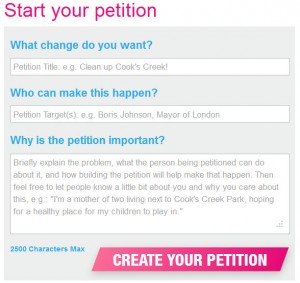 This is an interesting ‘tectonic’ move in the realm of (e)Participation, which we should follow closely. It is, additionally, much related to the discussion about “Sticks and Carrots” we hold in Pep-Net’s blog a year ago.
This is an interesting ‘tectonic’ move in the realm of (e)Participation, which we should follow closely. It is, additionally, much related to the discussion about “Sticks and Carrots” we hold in Pep-Net’s blog a year ago.
We were then reflecting about questions like: is it better to praise “good deeds” of Corporation and Politicians, or is it better to warn and punish them when they “misbehave”? Why not both things at the same time?
Anita Roddick, the founder of the Body Shop, reported that once an executive of Shell told her: “We don’t fear regulation, we only fear consumer revolt”
Well: it is clear now that consumer and citizens are getting better at revolting and exerting pressure. Change is happening out of anybody’s reach, and (e)Participation is slowly “getting teeth”, which soon will be able to hurt enough as to influence behaviour: if you do not want your brand reputation to get ruined… you better behave!!! And this applies to corporation as much as political actors.
The promise of a ‘Future Goverment’ that becomes FAST (flatter, agile, streamlined and tech-enabled) -which was delivered in the last World Economic Forum- starts to be truth. But, for sure, it is not government who is promoting it. It is NGOs and CSOs. It is citizens.
It is important to note that the technology behind these petition plattforms is very, very simple. The concepts and processes of use are also not sci-fiction. But for sure, this kind of powerful, sustainable and social minded (e)Participation was rarely promoted by our Governments’ Innovation Support Actions. Instead of an impact oriented eParticipation research, put at the service of Civil Society, a Government- and Academia-centred approach was preferred. And thus eParticipation has just advance by little steps.
It is a pitty, because these platforms are now out there, growing. They were created with less (or ‘no’) involvement of eParticipation researchers. And that means that we do not have easy access to the very valuable information about eParticipation that these systems are generating (about pattern and reasons of use, users’ demographics, typologies of action, success rates, etc).
We should reflect about this. We have not so many more opportunities to miss. The field is developing faster and faster. Do we want to be part of it?
]]>
A new digital engagement database is launched today by ParticiTech and Kind of Digital in association with Consumer Focus (UK).
Digitalengagement.org is different from other digital engagement databases in that it is a methods repository, not case study database. The website also doubles as a search engine, allowing methods to be matched based on a set of simple input criteria relating to the participation characteristics.
Give it a whirl and let me know what you think!
Read the full press release here
]]>
In this PeP-NET post we would like to share a tool we have developed, “The matrix of civic implication”, whose main aim is to support the development of conceptual clarity when analyzing participatory venues and participatory initiatives. If used wisely, we think the matrix is a powerful “tool”, that goes beyond alternative models (like OECD, IAP2 or Fung’s), and should allow researchers, practitioners and the ‘man in the street’ to better understand the core dimensions of participatory activities.
The Matrix of Civic Implication
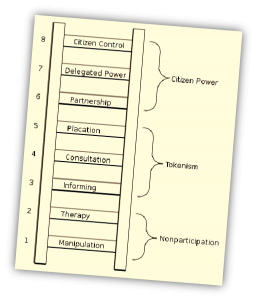 Since Sherry Arnstein presented her “Ladder of Citizen Participation” in 1969, tens of models have been proposed with the aim to describe “participation”.
Since Sherry Arnstein presented her “Ladder of Citizen Participation” in 1969, tens of models have been proposed with the aim to describe “participation”.
The problem with these models is that they tend to be either too basic -and thus they add less value- or they are too complex and specialized, and in this case they are too cumbersome to be applied.
For this reason… a lot of confusion exist in this field.
Our matrix tries to find a pragmatic balance between usefulness and complexity, and provide a tool that is at the same time powerful, practical and easy to use. It allows practitioners and theorists to compare in a matter of minutes different Participatory experiences. The model was developed to be applied to “municipal participation” initiatives, but it can be applied to other kind of participatory experiences.
The Matrix identifies four fundamental dimensions of participatory initiatives, which be informally “visualized”, and thus make this model especially suitable for comparing initiatives:
1. INTENSITY OF COLLABORATION:
This level is based on the original ladder, and describes the level of collaboration exercised. It goes from Manipulation, Information and Consultation levels up to the levels of Collaboration, Delegated Power and Delegated control. We have slightly renamed some of Arnstein’s rungs and added some fundamental extra rungs, like the ones corresponding to “Conflict” and the “transparency” rung, which is considered as a pre-requisite for any real “Collaborative Participation”. More details on the meaning of the different levels are provided below.
2. ACTORS involved in the participatory exercise:
This dimension allows differentiating the actors, grouping them under the categories of “affected”, “participants”, “promoters” and “decision makers”. It also classifies them as political actors, corporate actors, civil society actors, or others. More categories and actors can be considered. The ones shown in the picture are just an example. The actors’ names displayed in the attached matrix have just and illustrative character: more categories and actors could be considered, in case they were needed to analyze the participatory exercises. Thanks to the inclusion of this dimension, the model can be applied to analyze both “administrative, top-down participation” (sponsored and organized by governments) and “autonomous participation”, which could be really bottom-up (initiated by citizens) or initiated by some other Civil or Corporate actors. More details below.
3. INSTITUTIONALIZATION LEVEL:
This essential dimension has often been neglected in most participation models. The institutionalization levels range from the lowest “Sporadic” and “Episodic”, through “Periodic” and “Continuous” levels of institutionalization, to the highest “Functional Institutionalization” and “Organic Institutionalization”.
Functional Institutionalization refers to cases where laws have been approved that enact legal procedures and channels, which allow citizens to initiate some kind of participatory interaction. For example: citizens’ initiatives, right of petition, mandatory hearings in urban planning, participation in city council, etc.
Organic Institutionalization, finally, refers to the cases where participatory organs have been constituted with a permanent or semi-permanent character, with representation of different actors involved. These organs generally have a decision-making or a controlling mandate, and allow interested citizens and/or citizen groups to become involved in the policy areas covered by the participatory institution.
4. DELIBERATIVENESS:
This dimension allows to, informally, specify the kind and intensity of deliberation that the participatory experience motivates. Deliberation is a particular form of reasoning and dialogue, in which the costs and consequences of various policy options are carefully weighed, taking into account the views of all concerned.
The Matrix of Civic Implication is a tool that helps project managers, practitioners and researchers to describe what they are doing or what they are planning to do, taking into account the most fundamental participatory dimensions, and making it possible to compare between different options or approaches.
This conceptual model is intended to remain open and flexible: additions or changes are welcomed in the case the analyzed participatory experiences require them.
For example, it could be interesting to consider the moment within the “policy making cycle” (from Agenda Setting to Evaluation) where the participation happens. Another possible addition could consider the technological tools or the participatory methodologies used. But these extra dimensions are normally not essential to understand the core of the participatory experience, and are thus not part of the base model.
In many cases a participatory initiative is composed of different participatory activities, each of them with different aims and different stakeholders involved in them. The matrix could also be used to depict individually each of these activities, to get a deeper understanding of the whole experience.
The aim of the model is NOT prescriptive, but descriptive. It does NOT claim that higher intensity of collaboration, or a dense deliberativeness, or an extreme institutionalization level is always better. This actually depends of the environment and the objectives that are pursued with the initiative. The model thus explicitly recognizes that different situations require different approaches. It is the quality of participation that matters more, not the amount, nor necessarily the level at which it, suppossedly, happens.
The model is explained in these videos, which are part of the teaching materials we prepared for a course on “Citizen Participation and Digital Technologies”, that we imparted in collaboration with the Inter-American Organization for Higher Education. The course materials are in Spanish, but these videos include English subtitles:
YOUTUBE: 10.a. The Advent of Civic Implication. Part 1
YOUTUBE: 10.b. The Advent of Civic Implication. Part 2
More detailed descriptions of the “Intensity of collaboration” levels
Let’s have a more detailed look at the meaning of the “Intensity of collaboration” levels, starting with the lowest.
The rung “Manipulation”, that is part of the “Non-Participation” category is characterized by the attempts to manipulate: to keep people quiet, satisfied, with the impression that they are being heard… but actually there is no real intention to listen to them.
With different levels of sofistication, participatory venues are designed by decision-makers so they can exert control of it, and use it just to ratify decission that have already been taken, or to comply with legal requirements, etc.
All this was linked by Arnstein with the idea of “therapy”. And sadly enough… much of the political participation that is carried out nowadays is of this type.
Under the “Non-participation” level we have included the “Conflict” category.
This happens when citizens realise that the existing participatory venues are not satisfactory, and decide to show their dissatisfaction.
The firs rung, “Legitimate coercion”, is when the means used are “pacific”, civic protest, civil disobedience. We are speaking here of things like the Spanish “Indignados”, the #occupywallstreet movement, or the #realdemocracynow.
People’s capacity to connect one with another is increasing, and the current global crisis is evidencing that our current representative democracies are very “low-quality”. It is clear that this ‘Legitimate coercion’ will continue growing. Without losing its “pacific” character, this kind of action could win more and more disrupting capacity: coordinated demonstrations and strikes, boycotts, delays in paying taxes, etc. This coordinated actions can increasingly get directed at punishing political actors by means of voting, and thus “biting where it hurts” to them.
The rung of “Illegal Duress” refers to even stronger conflicts, and includes harder responses: sabotage, property destruction and robbery, terrorism… all this kind of actions can be understood, in many cases, as a way of expression when the “existing” mechanisms are considered as “non-working”.
With regards to the upper rungs: “Information, Consultation, Advisement”, they reflect the traditional levels in which a decision-maker can engage with people to improve the decisions.
The most basic rung -“Information”- means the case where some (or even much) information about what is being done, or planned to be done, is provided. That’s already a difference, with respect to “Manipulation”.
“Consultation” means that some channels (like polling, or focus groups, or… whatever you can imagine) are created that allow some kind of feedback from the citizens to be heard by the decision maker.
“Advisement” rung goes a little bit further, and allows that the citizens, their associations… are providing elaborate advice to the decision maker, as part of a conversation.
The most important aspect with regards to this category, called “Consultative Participation”, is that the decision maker is finally taking the decision that he prefers. She is just asking for opinions, argumentations, views… but retains the capacity to judge them and act in any way that suits her understanding and convenience. How much consideration receive the views expressed through the engagement mechanisms… depends entirely on the will of the decision maker. This is why Arnstein termed it “Tokenism”.
Let’s now go to the top.
Above the “Consultative Participation” category that we have just reviewd, the category for “Collaborative Participation” comes. This is the category where the “Intensity of Collaboration” is stronger. This is a type of participation where “real collaboration” is expected, in its various levels.
At the very top is the “Delegated Control” rung. It means that the control of some decision-making area is delegated to the participatory institution or organism. Usually the decision maker could reclaim the control in case of emergency… but by default he would be willing to accept the results of the participatory collaboration (normally, the decision maker will also be member of the participatory mechanism, and thus able to defend his interests).
The next rung, “Delegated Power” is a more conservative approach, that just delegates some partial, limited “power”, to the participatory institution. This way, more safeguards could be in place (veto, etc.).
The next level is “Collaboration”. In it, even if no power is explicitly delegated, the decision making capacity is implicitly or explicitly shared through the principles of “honest collaboration”, understanding that participants are partnering together to find good solutions. Thus what is recognized and agreed by means of this cooperation should necessarily influence, in a sensible way, the final decision, as well as the actions of all participants.
Thus, we come to the “Transparency” rung, which is the most radical change with respect to Arnstein model.
First of all: it is important to recognise that the nature of this rung is a little different than the others. It is more a “pre-requisite” for the collaborative participation than a way of collaboration on its own.
Why a pre-requisite? Well, because if you want to really collaborate, in a trustful way… all participants should have access to all relevant information available.
Transparency means open data and open government: a compromise to proactively share all relevant data, so all partners can inspect and work on it, both pro-actively (to ellaborate proposals, for example), or after some issue has happened (to discover ineficiencies or corruption, for example).
Transparency has a tremendous effect on the incentives of any administrative body. If you know that all your actions are visible, that they can be inspected… the ‘margin for corruption’ is strongly reduced.
Hidden agendas are also more difficult to keep: decision making can thus become more fact-based and deliberative, and all participants will be more motivated to find real “best solutions” and win-win arrangements.
For this reason, the “transparency” rung, and its “Pre-participation” category, are placed above the “Consultative Participation”. Consultative participation can actually happen under a dictatorial structure. Transparency is necessarily linked to collaborative and democratic settings.
One final remark: All this levels are, in first place, considered with relation to public authorities and government. But in general they can be applied to any institution with capacity to make decisions, and share this capacity with other stakeholders. In particular: corporations will increasingly be subject to demands to increase their “transparency”, as a requisite to collaborative participation of the people (which, should not be forgotten: are also customers, and able to harm companies in weeks, just by slightly coordinating their buying behavior).
Increasingly, if there is not enough transparency, or if the ethical behaviours of the companies are not satisfactory, people will go for “CONFLICT”, meaning boycotts or even stronger measures (imagine a coordinated action to retire funds from “un-ethical” banks: no public money will be able to save a bank whera a big share of their customers coordinately decide to claim their money back).
So… everybody should pay more attention to the developments in this field.
There is a strong demand for powerful collaboration tools. Internet is about to impact democracy, when the use of these tools gets critical mass. We should all try to make sure this happens in a constructive way.
How to handle top-down and bottom-up participation in the matrix
The Matrix intend to cover not only “top-down” public participation, but also the “bottom-up”. And even a new form of civic engagement we invented (partly, as a joke), called “from-the-middle-and-around”. Both the “top-down” and the “bottom-up” perspectives are too simple conceptualizations… that are not able to comprehend the nuances of such a complex phenomenom as civic engagement.
 In fact, we consider more interesting the bottom-up or mixed engagement models, as the pure “top-down”/ administrative participation has proven to be quite limited in its transformative effect during the whole 20th century. All this is related to the “administrative” and “autonomous” forms of participation that we previously referred to (see image).
In fact, we consider more interesting the bottom-up or mixed engagement models, as the pure “top-down”/ administrative participation has proven to be quite limited in its transformative effect during the whole 20th century. All this is related to the “administrative” and “autonomous” forms of participation that we previously referred to (see image).
Actually, it is because of this willingness to embrace autonomous “engagement” that we chose not to name the model the “Matrix of Citizen Participation” (following Arnstein) but the “Matrix of Civic Implication”.
Citizen Participation somehow suggest that “citizens” (no immigrants? no kids?) slightly “participate”, collaborate… with an initiative whose ownership lies somewhere else. “Civic implication”, on the other hand, aims to suggest an “engagement”, a “personal implication” with something that is recognized as “own” by person, by the neighbor.
How would the “top-down / bottom-up” character of the participation be reflected in the model?
Well, especially through the recognition and configuration of the “Actors” involved, at the top of the matrix, which by default is used to displays different possible administrative, corporate and civil society actors, as a way to facilitate the comparison of initiatives (see, for example, this comparation of “Mayor talks with neighbors” and the “Participatory Budgeting of Fortaleza (BR)”.
 Let’s imagine a case of bottom-up participation. For example, the case where the “participants”, “promoters” and “affected” are just the citizens of a neighborhood, which autonomously organize themselves (maybe with the support of a NGO) to propose the mayor (decision-maker) some kind of action… we would have this kind of autonomous participation in action.
Let’s imagine a case of bottom-up participation. For example, the case where the “participants”, “promoters” and “affected” are just the citizens of a neighborhood, which autonomously organize themselves (maybe with the support of a NGO) to propose the mayor (decision-maker) some kind of action… we would have this kind of autonomous participation in action.
If there is no request to be presented to the Mayor, but just a process of community self-organization… this would be reflected by not including any “decision-maker” or considering the “decision-maker” to be the own community.
And for sure, depending of the kind activities carried out (running a poll in the neighborhood, or deliberatively elaborate the proposal, or even voting at the end on the open points…) you would have different levels of involvement, or “intensities of collaboration”.
It is, anyway, just a tool -like, for example, scissors- whose real value is shown when it is put to work. In the same way that you would use slightly different scissors to clean a fish, to cut your fiancee’s hair, or to allow your daughter to handicraft… the matrix might need to be modified, extended, complemented with other analysis or… whatever, to suit the need of the user. It all depends on what is desired to illuminate with its help. The Matrix “humble aim” is to provide a clear base-line for analysis and communication. On top of that, all additions are welcomed, if they make sense.
Another example: in case there was interest in analyzing, or making more visible, the “power” relations in a concrete participatory initiative, you could decide to display only the actors that are participating, and perform some kind of “stakeholders analysis” to asses each actors’ power, urgency and legitimacy toward the issue, and thus determine the kind of role they can play (Dominant, Dormant, Dependent, Demanding, Definitive, etc.). [see https://www.jstor.org/pss/259247 ]. Thus, you could use different intensities of colors to reflect the power, etc.
That’s all, sorry for such a long entry. We thought it was worth sharing. We are waiting for your comments!
]]> The Consultation Institute (TCI) have launched what they believe to be the first quality scheme for public engagement software. Software vendors can apply for their tool to be tested against the principals of the TCI consultation charter which is a set of good practices. Assurances are also sought from existing customers and the package of training, support and help are scrutinised.
The Consultation Institute (TCI) have launched what they believe to be the first quality scheme for public engagement software. Software vendors can apply for their tool to be tested against the principals of the TCI consultation charter which is a set of good practices. Assurances are also sought from existing customers and the package of training, support and help are scrutinised.
This results in a test report, including actions and recommendations for product development enhancement generated by experts in eParticipation. Software and services which meet a certain grade will be granted the use of a logo which can be used on all marketing materials as a sign of product confidence.
An announcement will be made on 29th September regarding the first vendor to achieve successful accreditation during the annual TCI ‘Technologies for public engagement and consultation event’ (London).
For enquiries, please email Fraser.henderson@btinternet.com
]]>Because this paper needs to be read and, more important, discussed while its analyses are still current.
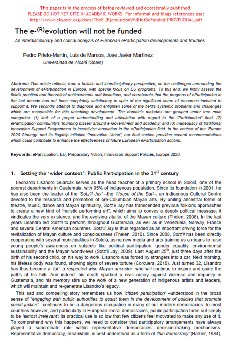 Thus, we have decided to make it provisionally available through PeP-NET. To start such a conversation, what better place than PeP-NET, the Pan European eParticipation network?
Thus, we have decided to make it provisionally available through PeP-NET. To start such a conversation, what better place than PeP-NET, the Pan European eParticipation network? ![]()
We have spent many hundreds of hours researching and writing the paper, as we struggled to make sense of the developments and “under-developments” of eParticipation in the last ten years.
Our appraisal is based on an extensive and interdisciplinary analysis of distinct relevant sources, which included the most recent reports, articles and literature reviews dealing with eParticipation research, practice and theory, as well as projects’ deliverables and evaluations, related databases, and our direct examination of eParticipation systems.
We had to resort to a very varied bunch of disciplines (from history and medicine to Mayan performing arts; seriously!! ![]() ) to be able to achieve a comprehensive understanding of the field’s challenges… and to make a compelling exposition of them.
) to be able to achieve a comprehensive understanding of the field’s challenges… and to make a compelling exposition of them.
The paper ended up being “quite controversial”, as our assessment of eParticipation came to suggest that some of the problems that have hampered its progress have a systemic, overarching character: that kind of ‘elephant in the living room’-issues whose very existence tends to be denied because of their complexity or the embarrassment they cause and, as a result, cannot normally be acknowledged or discussed, let alone get properly sorted out.
Examples of the “embarrassing questions” the paper poses are:
- How can it be that after 10 years… all relevant ‘agendas’ of eParticipation research are still reported as underdeveloped?
- And how can it be that even the most basic questions –for example: the relation of Participation and eParticipation, or the understanding of the dual nature of eParticipaton as something that can be driven by authorities or by citizens themselves– remain unsolved?
- More than 187 millions of Euros were invested in the last ten years to promote experimentation in the field, so… where are the results? Where are the breakthroughs and the research milestones? Can we feel satisfied with just some “vague confirmations” of ideas that 10 years ago could already have been easily guessed?
Through the paper, we have done our best to constructively diagnose eParticipation and to propose some treatments for the field’s maladies. But our perspective and understanding are necessarily limited: the real “treatment” for those problems would require a reflection process that involves the whole eParticipation community.
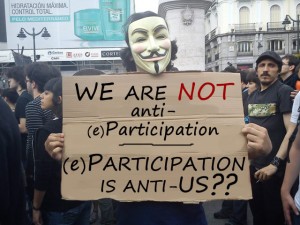 We see this paper as an urgent “call for self-reflection” and consider it a “MUST READ” for anyone involved in European eParticipation: from the officials working at EC’s Directorate for Information society and Media, to the researchers, practitioners, NGOs, public workers, citizen associations… and even any interested European citizen.
We see this paper as an urgent “call for self-reflection” and consider it a “MUST READ” for anyone involved in European eParticipation: from the officials working at EC’s Directorate for Information society and Media, to the researchers, practitioners, NGOs, public workers, citizen associations… and even any interested European citizen.
Therefore, we would like to encourage all our PeP-NET friends and in general all people with interest in eParticipation… to have a look at the paper during this nice summer weekend. ![]()
Anyone who feels “touched” by any of the paper’s claims and argumentations… should speak up and comment to this post. It doesn’t matter if it is to support, extend or complement our asseverations, or to oppose, challenge or further qualify them… please, share your views.
PeP-NET was meant to be a HUB for the conversations around eParticipation. So… let’s discuss. It is important that the issues we showed –be them real or imagined– are talked about, and possibly acted upon.
The environment where we operate is moving. Moving faster and faster. And in the context of the ‘Europe 2020 Strategy’ and its flagship initiative “Innovation Union”, which aims to renew EU’s “Research and Innovation Funding Programmes”, the most important question we need to answer is: “What do we do now??”
For sure, we could keep pretending that there is NO elephant in the living room. Stay in our “academic” Ivory Tower, and just continue doing as we did so far… while we wait for the “barbarians of eParticipation” to arrive, change the democratic landscape by really integrating ICT in governance… and make fools of all us. PeP-NET subscribers included. ![]()
But in our association we want to believe that we, the European eParticipation Community, could do much better than that.
So… no more to say!! Thank you very much for your attention. We hope some of you enjoy reading of our paper and some exchange of ideas can happen afterwards.
—– ADDITION: A CONCEPTUAL MAP SUMMARISING PAPER’S KEY FINDINGS —–
Several people asked for a “summary” version of the paper. Here you have a JPG image (2,5 Mbytes) displaying a Conceptual Map that summarises the paper’s key findings.
I recommend you to save the file first, and then open it with an image editor (like Office Picture Manager) to watch it. It’ll be more easy for you to zoom in and out in the different parts of the image.
—
Como resultado del nuevo escenario creado en España por movimiento cívico “15M”, que ha inundado las plazas de las principales ciudades españolas (y algunas del extranjero) con sus demandas de una “Democracia Real YA”, en la Asociación Ciudades Kyosei hemos decidido “ponernos las pilas”, para producir cuanto antes una versión alpha del sistema “Kyopol” (aka. “Ciudad Simbiótica”), que podamos poner al servicio de todos los procesos de activación cívica y movilización social que deberían ahora darse, barrio a barrio, en todas las ciudades de España.
Ello nos ha demandado un un cambio de actitud: se hace necesario establecer un equipo más amplio, repartir responsabilidades… y así crear algo útil cuanto antes.
Pues bien, tras un par de reuniones muy productivas ayer martes y el pasado domingo… ¡¡el proceso de creación del Sistema Kyopol se considera “oficialmente iniciado”!!
El Sistema Kyopol (aka. “Ciudad Simbiótica”) fomentará la Implicación Cívica y la “Activación Ciudadana” en los ámbitos municipal y regional. Permitirá a los ciudadanos informarse, formarse y colaborar unos con otros en la mejora de su entorno vital, trabajando en aquellas temáticas que cada uno considere importantes.
No sólo eso: buscaremos que usando el Sistema Kyopol… ¡¡podamos pasarlo “de miedo”!! Que sea una experiencia tremendamente placentera, incluso divertida, eso de unirte a otras personas para implicarte en el “cuidado de lo publico”.
Para la Asociación Ciudades Kyosei… ¡¡haber logrado alcanzar este hito es algo sensacional!! Queremos agradeceros a todos los simpatizantes de la asociación el apoyo que nos habéis brindado hasta ahora y advertiros… ¡¡que ahora es cuando empieza el trabajo de verdad!!
Nuestro trabajo se desarrollará a partir de ahora mediante la estrecha colaboración de dos equipos:
- Primeramente, el “Grupo impulsor” -compuesto por informáticos, investigadores y personas vinculadas con la participación- construirá prototipos del sistema y establecerá las metodologías, los recursos participativos y los arreglos institucionales que formarán parte del sistema.
- En segundo lugar, el “Colectivo de pioneros”, integrado por representantes de todos los colectivos que usarán el sistema (desde ciudadanos y asociaciones de vecinos a políticos y técnicos municipales, pasando por medios de comunicación, ONGs, sindicatos y partidos políticos y, por supuesto, ahora también movimientos sociales del estilo 15M, DRY y demás bichos que éstos engendrarán en los próximos meses), que nos ayudarán probando los sucesivos prototipos del sistema, y proporcionandonos feedback en relación a las funcionalidades y procedimientos que propongamos.
En base a ello, podremos disponer de una versión Beta del sistema, lo suficientemente madura para iniciar proyectos piloto. Primeramente en el entorno de Madrid -que es de donde provienen la mayoría de nuestros Pioneros”-, y posteriormente en todas las regiones de España, y finalmente en el ámbito Latino-Americano y Europeo.
Si tenéis interés en formar parte del “Colectivo de Pioneros”, por favor contáctanos cuanto antes.
Planeamos realizar un acto de presentación del proyecto a todos sus potenciales interesados, en las instalaciones de la Universidad de Alcalá. ¡¡Os invitamos a tod@s a que nos acompañéis en el evento!!
Os mantendremos informados (podéis seguirnos en la web de la asociación, facebook o twitter).
—–
Urged, and inspired, by the emergence of the #SpanishRevolution, which has crowded the main squares of many spanish cities (and several foreign ones too!) to demand a “Real Democracy NOW!”… we have tried to accelerate our association’s projects.
And… after a couple of very productive meetings on Tuesday and on last Sunday … the construction of the “Kyopol System” has been “officially started”!
Kyopol (aka. “Symbiotic City”) will promote “citizen activation” and civic involvement in the municipal and regional levels. It will allow citizens to inform themselves about civic issues, “educate” themselves on how to “participate”, and collaborate with each other to improve their shared living environment, by collaboratively working on those issues that each one considers important.
Actually, our aim is that by using Kyopol we citizens will be able to experience a great deal of fun (and proudness!). Isn’t that the way that “meeting fellow citizens to jointly care and work for the common good” should taste?!
For the Asociación Ciudades Kyosei… having reached this milestone is something sensational! We want to thank all supporters of the association for the help we have received so far, but also warn them… that the real work is about to start!!
Our work will be developed through the collaboration of two teams:
- First, the “Core Team”, which is mainly composed of developers and citizen participation’s researchers, practitioners and stake-holders, who will work together to construct prototypes and establish the participatory methodologie,s the formative resources and the institutional arrangements that will surround Kyopol.
- Second, a “Pioneers Team”, that integrates representatives of all groups that will use the system (citizens, neighbourhood associations, governments oficials, politicians, NGOs, media, social movements, etc…). They will act as “Alpha testers”, and will help us testing our prototypes and providing feedback in relation to the functionalities and the participatory methodologies and resources we propose.
Based on this work, we will construct a Beta version of the system, mature enough to initiate pilot projects. These will first first in the surroundings of Madrid, where most of our Pioneers are located, and will afterwards get extended to several regions in Spain, and finally to the wide Latin American (and European) environments.
The next milestone we are planning is a meeting at the University of Alcalá, where the project will be presented to all potential stakeholders. Collaborative work will start immediately afterwards.
We’ll keep you informed (and you can follow us on our website, facebook or twitter).
]]> We have seen countless examples of digital campaigns interlocking with offline activities aimed at protesting against something or the other. And even though I agree that protest campaigns can be very important we have seen far less examples of digital activism for a particular thing. I would like talk about one initiative that makes use of the net and our role as consumers to facilitate actual positive change in the offline world.
We have seen countless examples of digital campaigns interlocking with offline activities aimed at protesting against something or the other. And even though I agree that protest campaigns can be very important we have seen far less examples of digital activism for a particular thing. I would like talk about one initiative that makes use of the net and our role as consumers to facilitate actual positive change in the offline world.
The Carrotmob initiative was started in San Francisco in 2008 and wants to make use of strategic consumption to change businesses behaviour. The video below shows how this approach works:
How Organized Consumer Purchasing Can Change Business from carrotmob on Vimeo.
The key aspect is that all participants, consumers and businesses, can achieve their goals without damaging the other. The buycott (as opposed to boycott), as it is sometimes called, does make use of core market principles and therefore is a “capitalist friendly” way of activism.
Even though the actual actions or buycotts are very local the initiative has spread to many countries all over the world. The internet is used both to communicate on the worldwide scale and to organise the local events. The organisers make use of their own websites and platforms like Facebook or Twitter to, in the end, organize offline activities.
Form this point of view the net is just a tool which helps to globalize and organize a creative form of activism. But I would argue that this kind of coordinated action and the quick spread to this many countries would not have been possible without the use of the net a tool for communication.
Thanks to Thore for introducing me to the idea.
]]>



